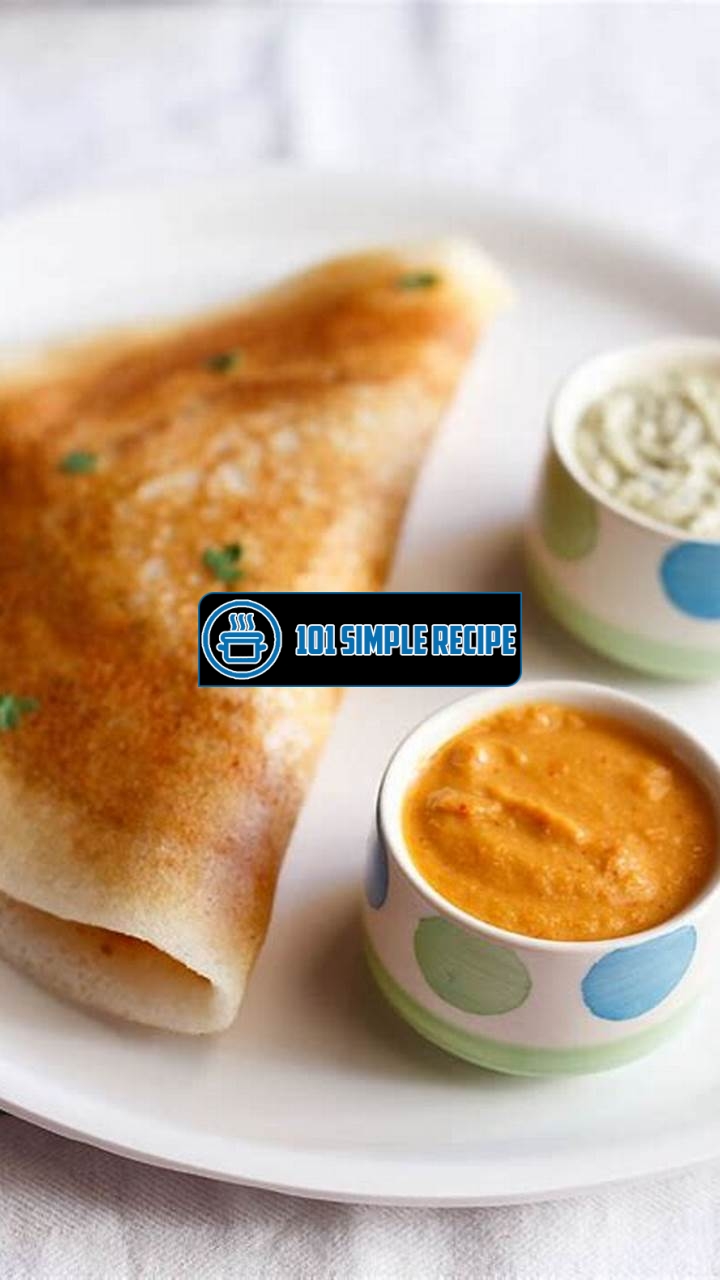If you’re a fan of South Indian cuisine, then you know that a delicious dosa is not complete without the perfect chutney by its side. Whether you prefer it spicy or mild, the right chutney can take your dosa experience to a whole new level. In this article, we will reveal the best chutney recipe that is guaranteed to tantalize your taste buds and leave you craving for more. Are you ready to elevate your dosa game? Let’s dive in!

The Origins of Chutney
Chutney has a fascinating history and is deeply intertwined with the culture and cuisine of various regions. This flavorful condiment has origins that can be traced back thousands of years.
In ancient times, chutney was known as “chatni” and was believed to have been introduced by the Indians. The word “chutney” itself is derived from the Hindi word “chatni,” which means “to lick.” This name perfectly captures the essence of chutney – a delicious accompaniment that enhances the taste of food and leaves you wanting more.
Chutney was traditionally made by grinding various ingredients together, such as fruits, vegetables, spices, and herbs. The exact combination of ingredients varied based on regional preferences and available resources.
Throughout history, chutney evolved and spread across different countries and cultures. As trade routes were established, chutney made its way to other parts of the world. It gained popularity in countries like Britain, where it was adapted to suit local tastes and ingredients.
Today, chutney is enjoyed in various forms and flavors all over the world. Its versatility lies in the fact that it can be sweet, savory, or spicy, depending on the ingredients used and the desired taste. This diversity and adaptability have contributed to its enduring popularity.
Chutney: A Condiment With a Rich Heritage
Chutney holds a unique place in the culinary world due to its rich heritage and cultural significance. It serves as more than just a condiment, often carrying with it stories of tradition and identity.
In many South Asian cultures, chutney is an essential accompaniment to meals, especially when it comes to dosa. It adds an extra layer of flavor and complexity to the dish, elevating the overall culinary experience.
Chutney is not only appreciated for its taste but also for the symbolism it represents. It is often seen as a way to preserve the flavors of a particular season or to celebrate a festival or special occasion. Making chutney is a communal activity, with families coming together to prepare large batches and share their recipes and techniques.
Additionally, chutney has medicinal and health benefits. Many of its ingredients are packed with nutrients and antioxidants, contributing to overall well-being. It is believed to aid digestion, boost immunity, and even have medicinal properties in some traditional practices.
Chutney’s Role in the Dosa Tradition
When it comes to dosa, chutney plays a vital role in enhancing the taste and texture of this popular South Indian dish. Dosa itself is a savory pancake made from a fermented rice and lentil batter. It is typically served with a variety of chutneys that complement its flavors and provide a contrasting element.
Chutney’s tanginess, spiciness, or sweetness can balance the subtle flavors of dosa and create a harmonious combination. Whether it’s the classic coconut chutney, the fiery tomato chutney, or the refreshing mint chutney, each variation adds a unique dimension to the dosa.
Traditionally, dosas were served with three types of chutneys – coconut, tomato, and tamarind. Each chutney had a distinct taste and texture, enhancing the overall gastronomic experience.
Today, the world of chutneys for dosas has expanded even further. Chefs and home cooks alike experiment with different ingredients, creating innovative chutney recipes that cater to diverse palates. From tangy mango chutney to spicy peanut chutney, the possibilities are endless.
Varieties of Chutney for Dosas
The range of chutneys available for dosas is truly remarkable. Here are some popular varieties:
- Coconut chutney: Made with freshly grated coconut, lentils, and flavored with spices, this classic chutney is creamy and mildly spiced.
- Tomato chutney: Tangy and slightly spicy, this chutney is made with tomatoes, onions, and spices, giving it a vibrant red color.
- Mint chutney: Refreshing and aromatic, this chutney is made with mint leaves, coriander, green chilies, and other ingredients to create a burst of flavor.
- Coriander chutney: Packed with the freshness of coriander leaves, this chutney offers a delightful blend of flavors with spices and lemon juice.
- Peanut chutney: Made with roasted peanuts, spices, and tamarind, this chutney has a nutty and tangy taste that pairs well with dosas.
These are just a few examples, but the world of chutneys for dosas is truly diverse and offers something for every taste preference.
In conclusion, chutneys have a rich history and hold a special place in the culinary traditions of many cultures. In the context of dosas, they elevate the dining experience and add layers of flavors. From the origins of chutney to its different variations, exploring the world of chutneys for dosas will surely enhance your gastronomic journey.
The Essential Ingredients
When it comes to creating a mouthwatering chutney to accompany your dosa, it’s important to have the right ingredients. Each component plays a crucial role in enhancing the flavors and creating a delightful sensory experience. Let’s explore the key ingredients that make a chutney recipe for dosa truly exceptional.
Aromatic Spices: Building Block of Flavor
No chutney is complete without a medley of aromatic spices. These spices not only add depth to the chutney but also infuse it with a tantalizing aroma that will transport you to the streets of India. The star spices that you should include are:
- Cumin seeds (jeera): With their warm, earthy flavor, cumin seeds form the foundation of many chutney recipes. They add a subtle nuttiness that complements the other ingredients perfectly.
- Mustard seeds (rai): These tiny seeds pack a punch, adding a burst of pungency. When popped in oil, they release a delightful aroma and give the chutney an extra kick.
- Fenugreek seeds (methi): Known for their slightly bitter taste, fenugreek seeds are used in moderation to balance the overall flavor profile. They also lend a unique touch to the chutney.
By using these aromatic spices, you can elevate your chutney from ordinary to extraordinary!
Balance of Sweet, Spicy, and Tangy
A well-balanced chutney should have the perfect harmony of sweet, spicy, and tangy flavors. This trifecta of taste sensations tickles your taste buds and enhances the overall enjoyment of the dosa. Here are some key ingredients that contribute to this balance:
- Tamarind: This tangy fruit pulp adds a pleasant sourness to the chutney. It balances the spiciness and brings a refreshing twist to every bite.
- Jaggery: To achieve the sweet element, jaggery or palm sugar is commonly used. Its subtle sweetness counteracts the fiery spices and adds depth to the chutney’s flavor profile.
- Green chilies: These vibrant chilies provide the necessary heat to the chutney. By carefully controlling the amount, you can adjust the spice level according to your preference. ️
By experimenting with these ingredients and finding the perfect balance, you can create a chutney that tantalizes your taste buds.
Local Ingredients: Authenticity in Taste
To truly experience the authentic flavors of a chutney for dosa, incorporating local and fresh ingredients is paramount. Using ingredients that are in season and locally available ensures that your chutney captures the essence of South Indian cuisine. Here are some local ingredients you can consider:
- Curry leaves: These aromatic leaves are a staple in South Indian cooking. Adding a handful of curry leaves to your chutney infuses it with a distinct flavor and fragrance.
- Coconut: Freshly grated coconut is a common ingredient that gives the chutney a luscious texture and a tropical taste. It creates a creamy base that balances the other flavors.
- Coriander: Cilantro or coriander leaves add a refreshing herbal note to the chutney. They not only enhance the taste but also provide a vibrant green color that makes the dish visually appealing.
By sourcing these local ingredients, you can ensure that your chutney stays true to its roots and delivers an authentic taste experience.
In conclusion, crafting the perfect chutney recipe for dosa requires paying attention to the essential ingredients. Aromatic spices, a balance of sweet, spicy, and tangy flavors, and the use of local ingredients all contribute to creating a memorable chutney. So, next time you prepare dosa, remember to give your taste buds a treat by whipping up this sensational chutney!
The Art of Chutney Preparation
When it comes to dosa, a flavorful chutney can take your culinary experience to the next level. Whether you prefer a classic coconut chutney or a tangy tomato chutney, mastering the art of chutney preparation is essential. In this article, we will explore the step-by-step process of preparing a delicious chutney that pairs perfectly with dosa.
Choosing the Right Equipment
Before embarking on your chutney-making journey, it is important to ensure that you have the right equipment. Here are a few essentials that you’ll need:
- Mixing Bowl: A sturdy mixing bowl is essential for combining all your ingredients.
- Blender or Grinder: To achieve the desired texture, you will need a blender or grinder to finely blend the ingredients. This will help bring out the flavors and create a smooth chutney.
- Spatula: A spatula will come in handy for scraping down the sides of the blender or grinder and ensuring all the ingredients are well incorporated.
Preparing and Roasting the Ingredients
Once you have gathered all the necessary equipment, it’s time to prepare and roast the ingredients. This step is crucial as it helps enhance the flavors and aromas of the chutney. Follow these steps to achieve the perfect flavor profile:
- Gather the Ingredients: Depending on the type of chutney you are making, the ingredients may vary. However, common ingredients include fresh coconut, roasted chana dal, green chilies, ginger, garlic, and spices such as mustard seeds and curry leaves.
- Roast the Ingredients: Heat a pan over medium heat and add a small amount of oil. Once the oil is hot, add the mustard seeds and curry leaves. Allow them to splutter and release their aroma. Next, add the green chilies, ginger, and garlic. Saute them until they turn golden brown. Finally, add the fresh coconut and roasted chana dal, and roast them until they turn slightly golden. The roasted ingredients will lend a unique and delicious flavor to your chutney.
- Cool and Grind: After roasting the ingredients, allow them to cool completely. Once cooled, transfer them to a blender or grinder. Add a little water and blend until you achieve a smooth consistency. The water helps in the grinding process and creates a creamy texture. If needed, add more water gradually to achieve the desired consistency.
Blending Techniques for Optimal Texture
To create a chutney with a perfect texture, it’s important to understand the blending techniques. Here are a few tips to achieve an optimal texture:
- Pulse and Grind: Start by pulsing the ingredients a few times to break them down. Then, gradually increase the speed and continue grinding until you achieve a smooth texture. This process helps retain the flavors while creating a creamy consistency.
- Scrape Down the Sides: While blending, make sure to scrape down the sides of the blender or grinder with a spatula. This ensures that all the ingredients are evenly incorporated and helps prevent any lumps or chunks in the chutney.
- Adjust Consistency: If your chutney is too thick, you can add a little water or coconut milk to thin it out. On the other hand, if it is too thin, you can add more coconut or roasted chana dal to thicken it. Adjust the consistency according to your preference.
Mastering the art of chutney preparation takes time and practice. By choosing the right equipment, preparing and roasting the ingredients, and understanding the blending techniques, you can elevate your dosa experience with a delicious chutney. So, next time you indulge in the popular South Indian dish, don’t forget to whip up a batch of homemade chutney to take it to a whole new level!
When making dosa, you can also try this chapli kabab recipe for a tasty meat dish.
Pairing Chutney with Dosas
When it comes to enjoying dosas, one of the key elements that can take your dining experience to the next level is the chutney that accompanies this beloved South Indian dish. With a wide variety of dosa options available, it is important to know how to pair them with the right chutney to truly elevate your culinary experience. In this article, we will explore the different dosa varieties and guide you on how to match them with complementary chutneys.
Classic Masala Dosa and Coconut Chutney
Elevate your dosa experience with the classic masala dosa served alongside a delectable coconut chutney. This traditional combination is a match made in culinary heaven, with the dosa’s crispy texture and flavorful potato filling perfectly complementing the creamy and mildly spiced coconut chutney.
Coconut chutney recipe:
- Ingredients:
- – Freshly grated coconut
- – Roasted chana dal
- – Green chilies
- – Ginger
- – Curry leaves
- – Mustard seeds
- – Oil
- – Salt to taste
- Instructions:
- 1. Blend the grated coconut, roasted chana dal, green chilies, ginger, and curry leaves into a smooth paste.
- 2. In a pan, heat some oil and add the mustard seeds. Once they splutter, add the paste and cook for a few minutes.
- 3. Add salt to taste and mix well. Your coconut chutney is ready!
Note: Feel free to adjust the spiciness of the chutney by adding or reducing the number of green chilies.
Spicy Onion Rava Dosa and Tomato Chutney
If you prefer a spicy kick to your dosa, the spicy onion rava dosa paired with tangy tomato chutney is a winning combination. The thin and crispy texture of the rava dosa, made from semolina, pairs perfectly with the robust flavors of the tomato chutney.
Tomato chutney recipe:
- Ingredients:
- – Ripe tomatoes
- – Onion
- – Garlic cloves
- – Red chilies
- – Tamarind paste
- – Mustard seeds
- – Curry leaves
- – Oil
- – Salt to taste
- Instructions:
- 1. Heat oil in a pan and add mustard seeds. Once they start to crackle, add finely chopped onions, garlic cloves, and curry leaves. Sauté until the onions turn translucent.
- 2. Add chopped tomatoes, red chilies, and tamarind paste. Cook until the tomatoes soften.
- 3. Allow the mixture to cool and then blend it into a smooth paste. Add salt to taste.
- 4. Your tangy tomato chutney is ready to be served!
Mysore Masala Dosa and Spicy Red Chutney
For those who crave a dose of heat, the Mysore masala dosa served with spicy red chutney will tickle your taste buds. The Mysore masala dosa is characterized by its red chutney spread on the inner side of the dosa, resulting in a burst of flavors with every bite.
️ Spicy red chutney recipe:
- Ingredients:
- – Dried red chilies
- – Garlic cloves
- – Tamarind paste
- – Onion
- – Salt to taste
- – Oil
- Instructions:
- 1. Heat oil in a pan and add dried red chilies. Sauté until they become slightly crisp.
- 2. Add chopped onions and garlic cloves. Sauté until they turn golden brown.
- 3. Allow the mixture to cool and then blend it along with tamarind paste and salt to taste.
- 4. Your spicy red chutney is ready to spice up your Mysore masala dosa!
By matching the right chutney with each dosa variety, you can enhance the flavors and create a truly memorable dining experience. Whether you prefer the classic combination of coconut chutney with masala dosa, the fiery kick of tomato chutney with onion rava dosa, or the spiciness of red chutney with Mysore masala dosa, these pairings are sure to take your dosa experience to new heights!
Cookie in a mug recipe is another quick and easy dessert option that you can try.
Chutney Variation for the Adventurous
When it comes to enjoying a delicious dosa, the chutney you pair it with can make all the difference. While traditional chutney recipes are undeniably delicious, sometimes it’s fun to add a twist and explore creative variations. Here, we present three unique chutney recipes that are sure to elevate your dosa experience and satisfy your adventurous taste buds.
Mint and Coriander Chutney: A Refreshing Blend
If you’re craving a burst of freshness in your dosa experience, look no further than this mint and coriander chutney. This vibrant green chutney combines the refreshing flavors of mint and coriander, resulting in a zesty and invigorating accompaniment. The mint adds a cooling sensation, while the coriander adds a subtle hint of citrus. This chutney pairs perfectly with any dosa variation and is a great way to add an extra layer of flavor to your meal.
To make this chutney, simply blend together a handful of fresh mint leaves, a small bunch of coriander leaves, a few cloves of garlic, a pinch of salt, a squeeze of lemon juice, and a green chili (optional for those who enjoy some heat). Once you have a smooth paste, you’re ready to enjoy this refreshing blend of flavors.
Peanut Chutney: Creamy and Nutty Delight
For those who crave a creamy and nutty chutney to enhance their dosa experience, the peanut chutney is an absolute delight. This rich and indulgent accompaniment is made with roasted peanuts, which give it a delightful crunch and a nutty flavor. The addition of spices such as cumin and chili powder adds a subtle kick. This chutney is perfect for those who enjoy a touch of decadence in their meals.
To make this creamy delight, simply roast a cup of peanuts until they turn golden brown. Allow them to cool and then grind them into a coarse powder. In a separate pan, heat some oil and add mustard seeds, cumin seeds, curry leaves, and a pinch of asafoetida. Once the spices start spluttering, add the peanut powder, salt, chili powder, and some water. Cook until the chutney reaches a desired consistency, and voila – your creamy and nutty peanut chutney is ready to elevate your dosa experience.
Tamarind Chutney: Sweet and Tangy Sensation
For those who enjoy the perfect balance of sweet and tangy flavors, the tamarind chutney is a must-try. This delicious chutney combines the natural sweetness of tamarind pulp with the tanginess of spices like ginger and chili powder. The result is a mouthwatering combination that adds a burst of flavor to your dosa. This chutney is particularly popular during festive seasons and is loved by both kids and adults alike.
To make this sweet and tangy sensation, soak a small ball of tamarind in warm water for about 15 minutes. Once it softens, extract the pulp by squeezing it with your hands. In a pan, heat some oil and add mustard seeds, curry leaves, ginger, and green chilies. Fry them for a minute and then add the tamarind pulp, jaggery, salt, and chili powder. Cook the mixture until it thickens, and you’re left with a luscious tamarind chutney that will take your dosa experience to the next level.
Peanut chutney recipe is a delicious accompaniment for dosa. It adds a burst of flavor to the dish.
Frequently Asked Questions
Here are some frequently asked questions about making chutney for dosa:
| No. | Questions | Answers |
|---|---|---|
| 1 | What are the key ingredients for chutney? | The key ingredients for chutney include fresh coconut, roasted chana dal, green chilies, ginger, curry leaves, and tamarind. These ingredients give the chutney its unique flavor and texture. |
| 2 | Can I customize the chutney recipe? | Absolutely! You can customize the chutney recipe by adding or reducing the amount of spices and ingredients according to your taste preferences. Feel free to experiment and find the perfect balance of flavors. |
| 3 | How long does the chutney stay fresh? | The chutney can stay fresh for up to 3-4 days when stored in an airtight container in the refrigerator. Make sure to consume it within this timeframe to enjoy its full flavor. |
| 4 | Can I freeze the chutney? | Yes, you can freeze the chutney in an airtight container for up to 2 months. Thaw it in the refrigerator overnight before using, and give it a good stir before serving. |
| 5 | What are some variations of chutney for dosa? | There are several variations of chutney that pair well with dosa. Some popular options include tomato chutney, onion chutney, coriander chutney, and mint chutney. Each variation adds a unique twist to the dosa experience. |
| 6 | Can I use a blender to make the chutney? | Yes, using a blender is a convenient way to make chutney. However, for a traditional touch, you can also use a mortar and pestle to grind the ingredients and achieve a slightly coarse texture. |
Thank You for Reading!
We hope you enjoyed learning about the chutney recipe for dosa. Now it’s time for you to try it out in your own kitchen and experience the burst of flavors it brings to your dosa. Don’t forget to visit our website again for more exciting recipes and culinary inspiration. Happy cooking!
Jump to Recipe
Chutney Recipe for Dosa

Learn how to make delicious chutney for dosa with this easy recipe. The chutney is made with fresh coconut, roasted chana dal, green chilies, and other aromatic spices. It adds the perfect balance of flavors to your dosa experience.
- 1 cup fresh coconut
- 2 tablespoons roasted chana dal
- 2-3 green chilies
- 1- inch piece of ginger
- 10-12 curry leaves
- Small lemon-sized tamarind
- Salt to taste
- For tempering: 1 tablespoon oil (1 teaspoon mustard seeds, 1 teaspoon cumin seeds, a pinch of asafoetida)
- For garnish: Fresh coriander leaves
- In a blender, add fresh coconut, roasted chana dal, green chilies, ginger, curry leaves, tamarind, and salt. Grind to a smooth paste, adding a little water if needed.
- In a pan, heat oil and add mustard seeds. When they splutter, add cumin seeds and asafoetida. Pour this tempering over the chutney and mix well.
- Garnish with fresh coriander leaves and serve the chutney with dosa for a delightful meal.





